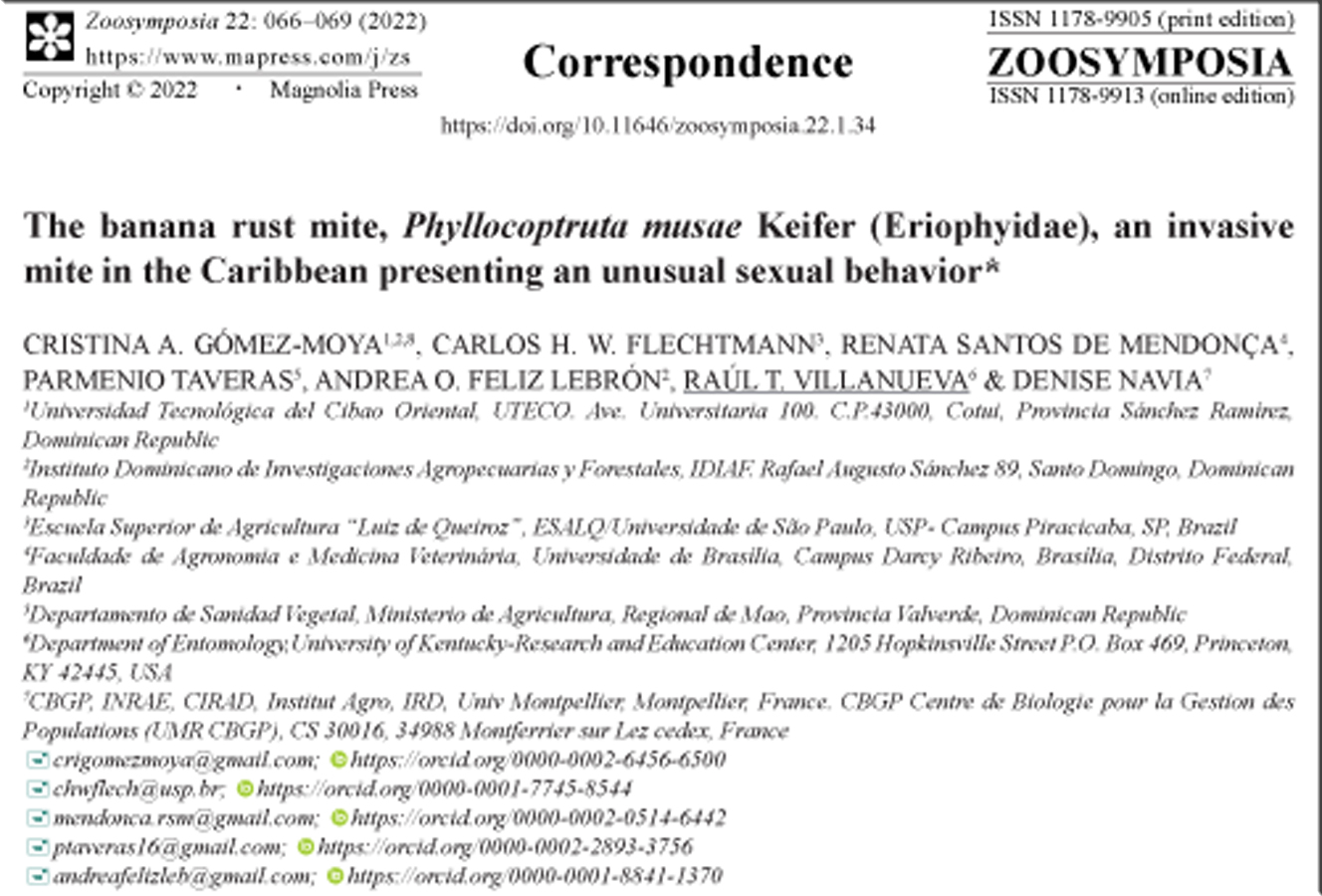Abstract
The banana rust mite, Phyllocoptruta musae Keifer, 1955 (Eriophyidae), was observed for the first time in the Caribbean in 2020, in Dominican Republic, in the Línea Noroeste region, Valverde and Monte Cristi provinces, infesting Musa acuminata plantations (Gran Enano and Williams hybrids) (Gómez-Moya et al., 2021). This eriophyid mite was described from Queensland, Australia on Musa x paradisiaca L. (Keifer, 1955). In the Eastern Hemisphere, besides Australia P. musae had been reported from China, in the autonomous region of Guangxi Zhuang; on Hainan Island, and in Thailand (Li et al., 2007; Tan et al., 2014; Chandrapatya et al., 2016; Amrine & de Lillo, personnal communication). In Australia infestations were reported causing fruit spotting (Keifer, 1955).
References
Chandrapatya, A., Konvipasruang, P. & Amrine Jr, J.W. (2016) Present status of eriophyoid mites in Thailand. Proceedings of the International Congress of Acarology, 2014, Tokyo. Journal of the Acarological Society of Japan, 25(S1), 83–107. https://doi.org/10.2300/acari.25.Suppl_83
Feliz-Lebrón, A.O., Gómez-Moya, C.A., Mendonça, R.S., Navia, D., Villanueva, R. & López-Rodríguez, G. (2022) Estudios sobre Phyllocoptruta musae Keifer (Acari: Eriophyidae) en el Neotrópico: Distribución, dinámica, sintomatología y caracterización genética de sus poblaciones. In: FONDOCYT 2022. Programa y Resúmenes: XIV Seminario de Investigación Científica e Innovación Tecnológica. Ministerio de Educación Superior, Ciencia y Tecnología, MESCYT, nov. 8, Santiago, República Dominicana, pp. 63.
Flechtmann, C.H.W. & J. Etienne. 2004. The red palm mite, Raoiella indica Hirst, a threat to palms in the Americas (Acari: Prostigmata: Tenuipalpidae). Systematic and Applied Acarology, 9, 109–110. https://doi.org/10.11158/saa.9.1.16
Gómez-Moya, C.A., Amrine Jr., J.A., Flechtmann C.H.W., Campos, D., Navia, D. & Suárez, P. (2021) First record of Phyllocoptruta musae (Acari: Prostigmata: Eriophyidae) in the neotropics, in Hispaniola. Novitates Caribaea, 18, 209–213. https://doi.org/10.33800/nc.vi18.271
Hirst, S. (1924) On some new species of red spider. Annals and Magazine of Natural History, 14, 522–527. https://doi.org/10.1080/00222932408633151
Keifer, H.H. (1955) Eriophyid studies XXIII. Bulletin of the California Department of Agriculture, 44,126–130.
Li, D.-W., Wang, G.-Q. & WEI, S.-G. (2007) A new genus and three new species of Phyllocoptinae (Acari: Eriophyidae) from South China. Zootaxa, 1587, 53–59. https://doi.org/10.11646/zootaxa.1587.1.4
Michalska, K., Skoracka, A., Navia, D. & Amrine, J.W. (2010) Behavioural studies on eriophyoid mites: an overview. Experimental and Applied Acarology, 51, 31–59. https://doi.org/10.1007/s10493-009-9319-2
Navia, D. & Marsaro Jr., A.L. (2010) First report of the citrus Hindu mite, Schizotetranychus hindustanicus (Hirst) (Prostigmata: Tetranychidae), in Brazil. Neotropical Entomology, 39(1), 140–143. https://doi.org/10.1590/S1519-566X2010000100021
Navia, D., Marsaro, A.L. Jr., Gondim, M.G.C. Jr., Mendonça, R.S. & Pereira, P.R.V.S. (2013) Recent mite invasions in South America. In: Peña, J. (Ed.) Potential Invasive Pests of Agricultural Crops. CAB International, Boston, pp. 251–287. https://doi.org/10.1079/9781845938291.0251
Potter, D.A., Wrensch, D.L. 1978. Interrupted matings and the effectiveness of second inseminations in the two spotted spider mite. Annals of the Entomological Society of America, 71, 882–885. https://doi.org/10.1093/aesa/71.6.882
Proctor, H.C. (1992) Mating and spermatophore morphology of water mites (Acari: Parasitengona). Zoological Journal of the Linnean Society, 106, 341–384. https://doi.org/10.1111/j.1096-3642.1992.tb01250.x
Tan, M.-C., Huang, L.-F., Fu, Y.-G. & Wang, G.-Q. (2014) One new genus and two new species of Phyllocoptini (Acari: Eriophyidae) from Hainan Island, South China. International Journal of Acarology, 40(7), 513–518. https://doi.org/10.1080/01647954.2014.957720
Tien, N.S.H., Massourakis, G., Sabelis, M.W. & Ega, M. (2011) Mate choice promotes inbreeding avoidance in the two-spotted spider mite. Experimental and Applied Acarology, 54, 119–124. https://doi.org/10.1007/s10493-011-9431-y
Vacante, V. (2015) Mites of Economic Plants: Identification, Bio-ecology and Control. Mediterranean University of Reggio. Calabria, Italy, 876 pp. https://doi.org/10.1079/9781845939946.0001


